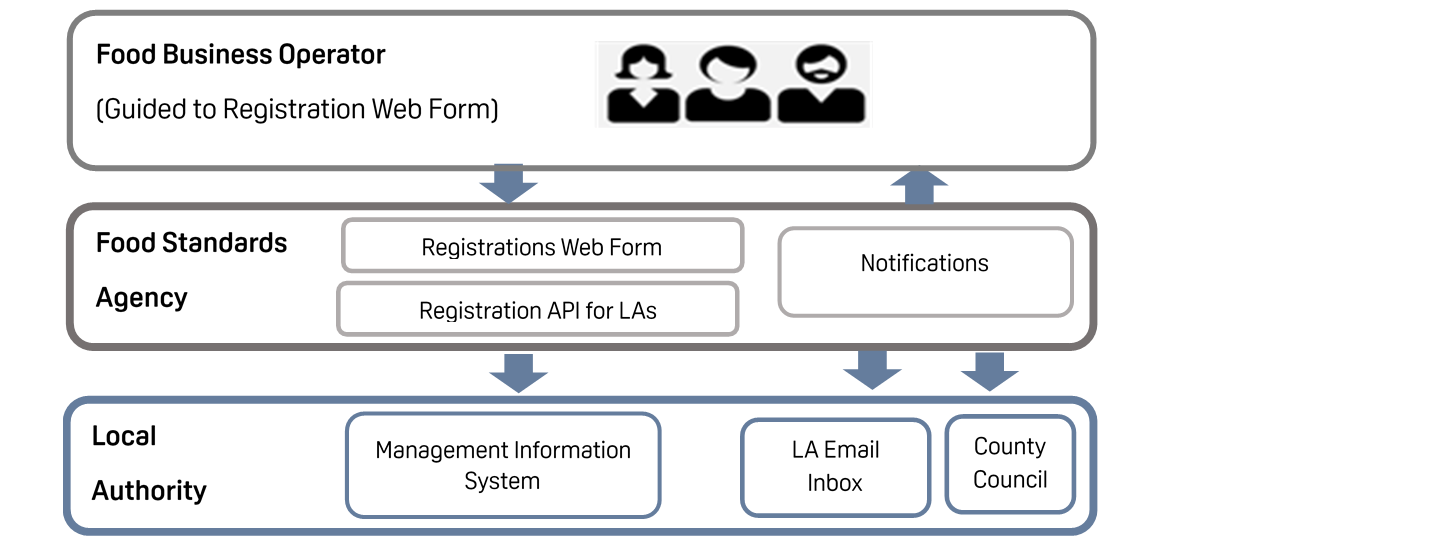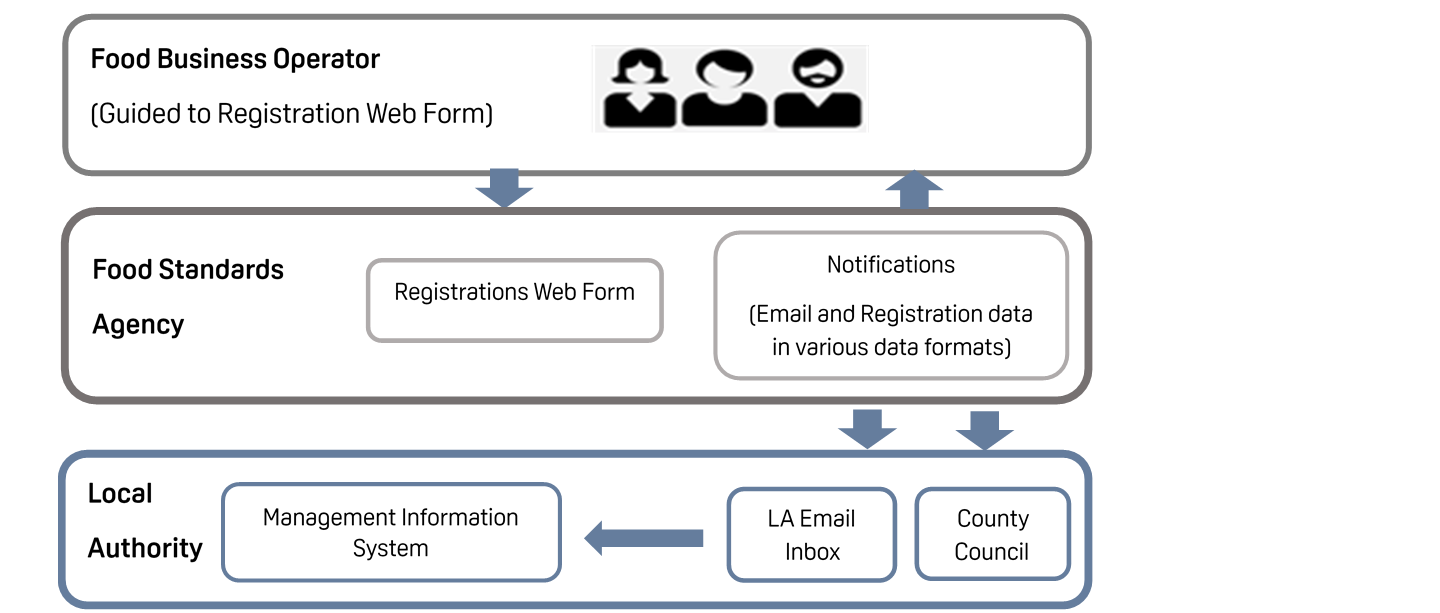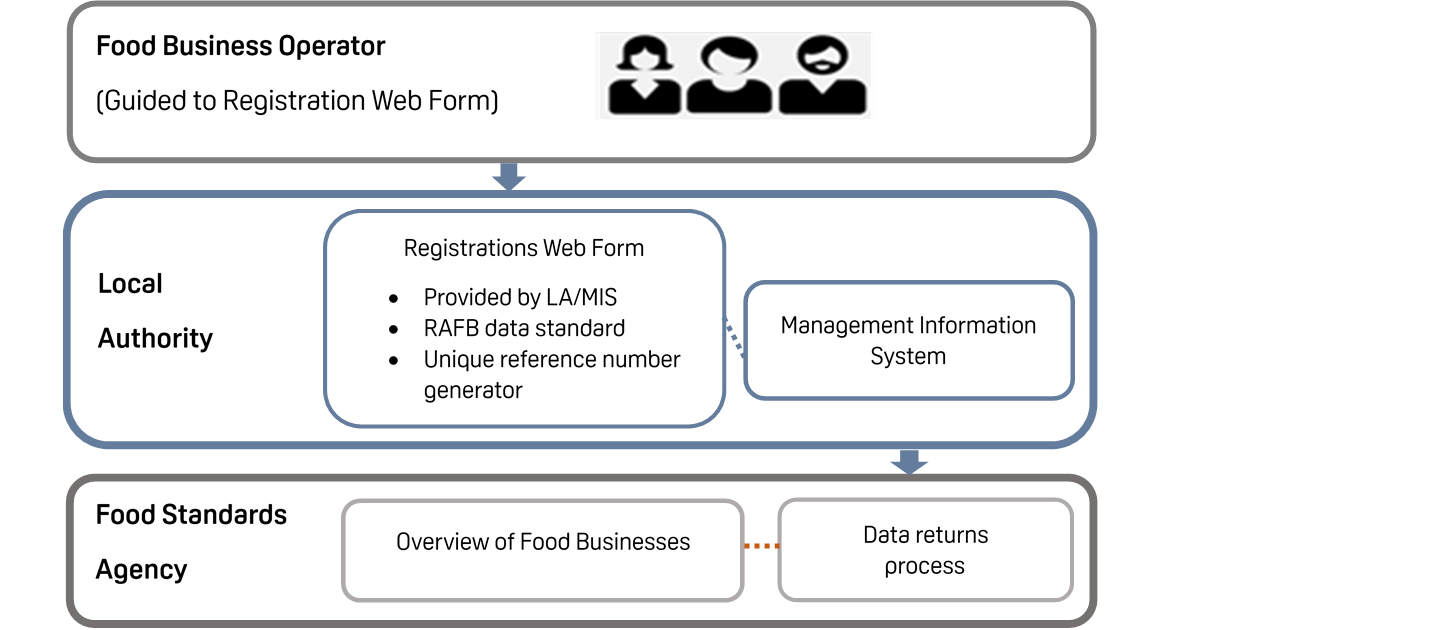13th Regulating Our Future Newsletter
In this edition of the newsletter, we focus on some of the projects, currently underway, which are making this vision a reality. Beverley Küster, Head of Enhanced Registration, describes the Register a Food Business (RAFB) part of the programme in the video below, and Colin Kelly, Environmental Health Manager (Commercial) at Antrim & Newtownabbey Borough Council shares his experience of using the new system. We also update on where we are with our work on National Inspection Strategies and how these may impact the current Food Hygiene Rating Scheme.
We hope you find this useful and informative. As always, we are keen to hear from you, please do get in touch with us at Futuredelivery@food.gov.uk
Maria Jennings
Director of Regulatory Compliance, People and NI
Register a Food Business
We are continuing to roll out the new digital food registration service, ‘Register a Food Business’ (RAFB). This service enables local authorities (LAs) to capture consistent and high-quality registration data and makes it easier for food business operators (FBOs) to register and receive relevant information and guidance about starting up their new business.
Currently we have 56 local authorities across England, Wales and Northern Ireland now onboarded, and we have received over 2000 digital registrations since the new service was launched in September 2018.
Three approaches have been developed to make the adoption of Register a Food Business (RAFB) by LAs easier and more flexible:
Integrated Approach (Option 1): Registration data feeds into the LA's Management Information System

Image showing registration data feed into the LA's Management Information System. The food business operator is guided to the registration web form, which they complete and this information is shared with the FSA and registrations API for the LA. This then feds into the LA Management information system. Throughout the process, notifications keep the food business operator, Local authority and county council updated.
Non-integrated Approach (Option 2): The LA receives data in a chosen data format without integration

image showing the LA receives data in a chosen data format without integration. The food business operator is guided to the registration web form, which they complete and this information is shared with the FSA and registrations API for the LA. This then feds into the LA Management information system. Throughout the process, notifications keep the food business operator, Local authority and county council updated.
Design & Data Standards (Option 3): The LA uses its own digital registration front-end and captures information according to FSA data standards using a FSA reference number generator to ensure uniqueness

Image showing LA uses its own digital registration front-end. The food business operator is guided to the registration web form, which they complete and this information is fed into the LA registrations web form, provided by the Local authority or Management information system. Information meets the rafb data standards and uses a unique reference number generator. The information is then shared with the FSA via data returns process and feeds into an overview of food businesses.
As a part of a proof of concept for the integrated approach, we have been working with a small number of LAs and their management information system (MIS) provider to show how an integrated end-to-end digital registration could work: When a food business operator registers their business online through the service, the data can be easily collected and efficiently imported into the LA’s MIS or database for checking and acceptance. We have been making good progress and currently have 21 LAs using this approach across England, Wales and Northern Ireland.
The feedback from the early adopting LAs has been invaluable in developing the service further, and we have recently released version 8.0 of the Register a Food Business (RAFB) service which now captures information on opening hours and mains and private water supply in direct response to LA feedback.
As a result of recent engagement, many LAs have expressed an interest in the non-integrated approach. We have developed a comprehensive rollout program to support LAs connect to the service and started to implement this in September 2019. We currently have 33 LAs using non-integrated approach and our aim is to onboard over 100 LAs over the next six months. We will be contacting these interested local authorities at some point over the next six months based on their preferred connection date.
As part of the Design and Data Standard approach we are also working with a LA pilot group who would like to use their own registration platforms to ensure it aligns with our registration data standard. We will keep you updated on progress with this option. Currently, two LAs are using this approach.
Going forward, we will continue to engage with local authorities to maximise the uptake of the new digital registration service across the local authority community over the next 12-18 months. The feedback we receive from food business operators and local authorities will be used to help develop the digital service and enhance the registration process.
We understand the importance of engaging with LA management information system providers and will continue to do this and discuss how they can best connect to the service.
Antrim and Newtownabbey Borough Council is one of 21 LAs across England, Wales and Northern Ireland that have been using the integrated approach as part of the proof of concept. Environmental Health Manager (Commercial), Colin Kelly gave us his view on his experience with RAFB and the benefits to his team.
‘We have been implementing the new digital food business registration service, ‘Register a Food Business’ (RAFB) over the last nine months.
‘A key benefit to the team has been the digital capture of food businesses registration information, in a consistent and legible format, which has resulted in less time spent on follow up queries by my team with the new food business to correct inaccurate or missing information.
‘New food business operators can now instantly register online without the need of a paper copy form and the information provided at the time of registration, seamlessly enters our management information system with the avoidance of manual entry of data and this then enables an immediate overview of new registrations received.
‘The food safety team has received positive feedback from food business operators, who have been able to register their business quickly and easily; and they can also receive sign posting to relevant information and guidance upon registration.
‘Connection to the RAFB service has been a journey and the process has had several changes and developments along the way. It has become very user friendly for food businesses, and there are benefits to our food team and the food business operators which allows for more efficient and effective registration and monitoring processes.’
Colin Kelly
Environmental Health Manager (Commercial)
Antrim & Newtownabbey Borough Council
If your LA has not yet signed up to the new Register a Food Business (RAFB) service and would like more information or to get involved and help shape its future development, please contact us by emailing Futuredelivery@food.gov.uk.
Primary Authority National Inspection Strategies (PA NIS) and the Food Hygiene Rating Scheme (FHRS)
We are continuing our work to explore how Primary Authority national inspection strategies (NIS) can contribute to the regulation of compliant businesses or groups of businesses.
In essence, where a NIS has been recognised by the FSA, the primary authority will take responsibility for assessing compliance across the business and give direction to other local authorities on where and how often proactive interventions should be undertaken at individual outlets.
We have developed and consulted on three FSA NIS Standards for food, which together give a framework for oversight and assurance:
- NIS Primary Authorities’ Standard which partnerships must meet if they want to have a NIS recognised by the FSA
- NIS Recognition Standard how the FSA will assess NIS proposals
- NIS Assurance Standard which details FSA oversight of primary authorities operating a NIS
We are encouraging and supporting partnerships to develop NIS proposals for ‘live trials’ to see how they might work in practice and to assess whether the draft standards are fit for purpose. We will provide further updates on the trials in future newsletters.
We recognise that the implementation of NIS will have an impact on the Food Hygiene Rating Scheme (FHRS) as it will reduce the frequency of onsite inspections at individual outlets. We are committed to ensuring that the FHRS remains robust and credible so we are exploring potential options for managing this impact (though we will not be testing them as part of the live trials).
Early thinking has been around three options:
The first is for outlets that are part of a NIS simply to retain the rating and inspection date from the most recent local authority inspection. This would mean that published ratings become historic over time, although other interventions may be undertaken between planned inspections. Businesses could request a re-inspection, between the planned inspections, for which any local authority charges would apply.
The second is for ratings to be ‘refreshed’ based on NIS evidence confirming that the existing rating is still appropriate. The rating date would be updated on the FSA website and a new sticker issued to the business. Again, businesses could request a re-inspection, between planned inspections, for which any local authority charges would apply. If the establishment is identified for local authority inspection, based on NIS and local authority evidence or as part of any NIS 'benchmarking', a new rating would be given based on that inspection.
The third option is for ratings to be based on NIS evidence. This means they may change (go up or down), based on that NIS evidence. The rating and the rating date would be updated on FSA website and a new sticker issued.
Development of these options is still at an early stage and we are taking into consideration, independently conducted research into the views of consumers and businesses, and feedback received so far, which indicates that any other sources of evidence used to award a rating need to be equivalent to the evidence gathered at a physical inspection.
We will be engaging with stakeholders more widely to explore these and any other options that emerge and the input we receive will help inform our future thinking.
We welcome your comments and feedback on this Newsletter and its content. Get in touch by emailing Futuredelivery@food.gov.uk
Figures correct at time of publishing